Vous cherchez une revue de Recipe Card Blocks pour vous aider à décider si c'est le bon plugin de recettes pour vous ?
Avec ce plugin, vous pouvez créer des fiches de recettes multimédias présentant des images, des guides vidéo, des instructions étape par étape et des liens d'affiliation. Vos lecteurs peuvent interagir avec ce contenu en postant des commentaires et des notes en étoiles, ou en partageant vos recettes sur les plateformes de médias sociaux populaires.
Dans cette revue de Recipe Card Blocks, nous examinerons ce plugin populaire pour voir s'il convient à votre site WordPress.

Recipe Card Blocks : Pourquoi l'utiliser dans WordPress ?
Recipe Card Blocks est un plugin populaire qui vous permet d'ajouter des fiches de recettes à votre site en utilisant l'éditeur de blocs WordPress.
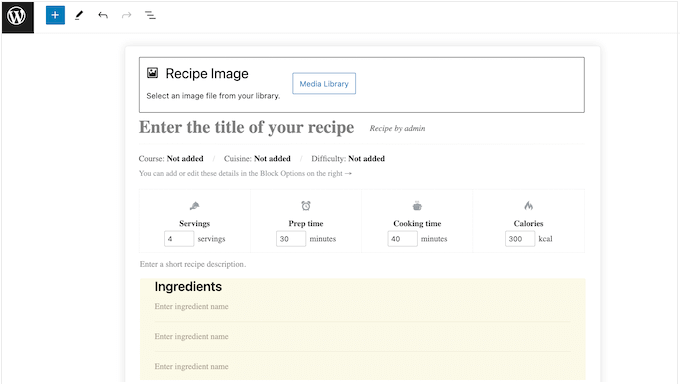
Il est livré avec plusieurs mises en page de cartes, et des options de personnalisation simples pour que vous puissiez affiner l'apparence de vos cartes.
Recipe Card Blocks ajoute également automatiquement des données structurées à votre site, ce qui encouragera les moteurs de recherche à présenter vos recettes comme des extraits enrichis. Cela vous aide à vous démarquer dans les SERP et augmente souvent le trafic de votre blog.
Si vous débutez ou si votre budget est limité, vous pouvez télécharger la version lite de Recipe Card Blocks depuis WordPress.org.

Ce plugin vous permet de créer un nombre illimité de cartes avec des images, des vidéos et des informations nutritionnelles. Il ajoutera également des données structurées correctement formatées à votre site, afin que vos recettes soient plus susceptibles d'apparaître dans les résultats de recherche pertinents.
Cependant, le plugin premium offre aux visiteurs plus de moyens d'interagir avec votre contenu. Pour commencer, ils peuvent laisser une évaluation par étoiles et convertir les recettes entre les unités coutumières américaines et métriques. Ils peuvent également filtrer vos recettes en fonction de facteurs tels que le niveau de difficulté et la cuisine, ce qui est parfait pour les visiteurs qui recherchent de l'inspiration.
Revue de Recipe Card Blocks : Est-ce le bon plugin de recettes pour vous ?
Si vous tenez un blog culinaire, un plugin de recettes peut afficher votre liste d'ingrédients, vos vidéos, vos images et vos informations nutritionnelles dans une belle mise en page. Cela aide les lecteurs à suivre vos instructions et à cuisiner quelque chose de délicieux en toute simplicité.
Cela peut améliorer l'expérience du lecteur, ce qui réduira le taux de rebond et incitera les gens à revenir sur votre blog culinaire. Cela dit, voyons si le plugin Recipe Card Blocks vous convient.
1. Facile à utiliser
Recipe Card Blocks est conçu dans un souci de simplicité d'utilisation. Pour commencer, vous pouvez l'installer et l'activer, comme n'importe quel autre plugin WordPress.
Lors de l'activation, Recipe Card Blocks ajoute une nouvelle section au tableau de bord WordPress où vous pouvez créer autant de recettes que vous le souhaitez. Dans cet éditeur, vous pouvez ajouter des informations détaillées, y compris les ingrédients et l'équipement requis, la taille des portions, le temps de préparation et une image mise en avant.

Lorsque vous êtes satisfait de la configuration de la recette, vous pouvez l'ajouter à n'importe quelle page ou article en utilisant un shortcode que le plugin crée automatiquement.
De cette façon, vous pouvez afficher la même recette dans plusieurs endroits sans avoir à la recréer manuellement à chaque fois.
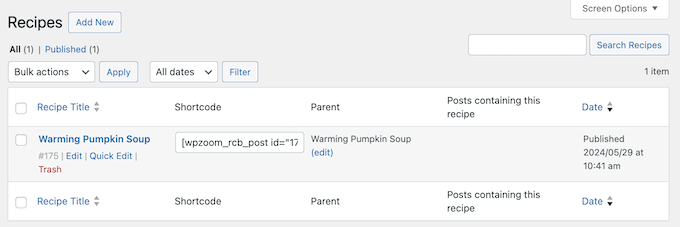
Alternativement, vous pouvez créer des recettes dans l'éditeur de contenu WordPress, en utilisant le bloc Recipe Card. Ajoutez simplement ce bloc à n'importe quelle page, puis tapez les informations que vous souhaitez utiliser.
2. Fonctionne avec n'importe quel thème WordPress
Ces cartes de recettes sont conçues pour fonctionner avec n'importe quel thème WordPress. Cela signifie que vos cartes seront superbes et fonctionneront correctement, même si vous changez de thème après les avoir ajoutées à votre site web.
3. Cartes entièrement personnalisables
Avec ce plugin, vous pouvez personnaliser vos cartes de recettes pour qu'elles correspondent parfaitement à votre entreprise ou à votre image de marque personnelle, et à votre thème WordPress.
Pour commencer, vous pouvez choisir entre 5 styles de cartes de recettes différents.

Vous pouvez également modifier la couleur primaire par défaut et la couleur de vos évaluations par étoiles.
Quelle que soit la façon dont vous configurez ces paramètres par défaut, vous pouvez les remplacer pour des cartes spécifiques. Par exemple, dans l'éditeur de contenu WordPress, vous pouvez basculer entre différents styles de cartes de recettes et choisir exactement les informations que vous souhaitez afficher dans cette carte particulière.
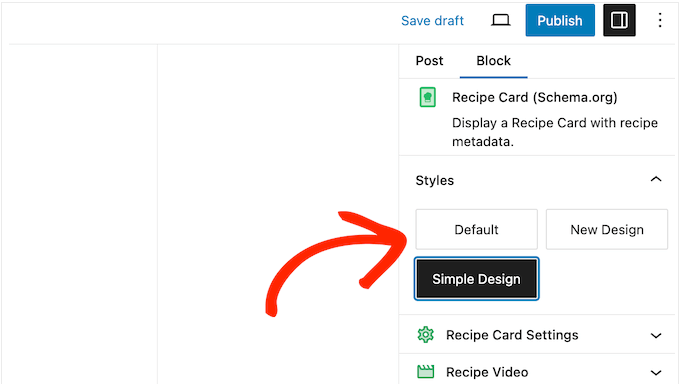
Vous souhaitez apporter des modifications plus avancées ? Alors Recipe Card Blocks prend également en charge les CSS personnalisés. De cette façon, vous pouvez créer des designs entièrement uniques avec des polices personnalisées, votre propre schéma de couleurs, et plus encore.
4. Ajouter en masse des ingrédients et des instructions
Pour vous faire gagner du temps et des efforts, Recipe Card Blocks dispose d'un éditeur en masse qui vous permet d'ajouter plusieurs ingrédients et instructions à la fois. Il suffit d'ajouter chaque élément sur une ligne séparée, et le plugin s'assurera qu'ils sont correctement formatés.

Cette fonctionnalité est particulièrement utile lorsque vous copiez/collez des recettes existantes dans votre blog culinaire WordPress.
5. Images de recettes attrayantes
Lorsqu'ils recherchent une recette, la plupart des lecteurs regardent d'abord les photos de la recette. Cela signifie que des photos appétissantes sont indispensables pour tout site Web culinaire.
Cela dit, vous pouvez ajouter une image principale, une image mise en avant à chaque carte de recette.
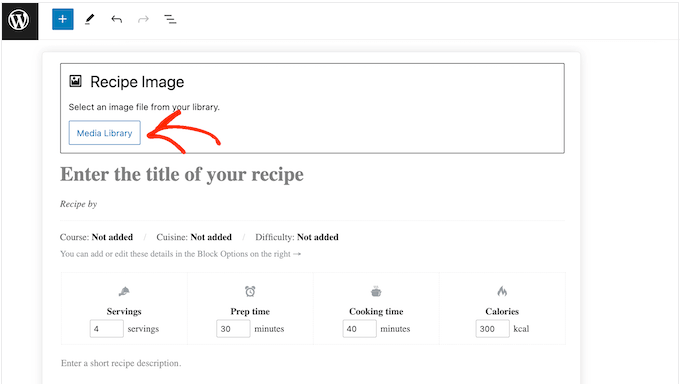
6. Galerie dans les instructions
Les images peuvent aider les lecteurs à comprendre les étapes qu'ils doivent suivre pour suivre votre recette.
D'autres fois, des images supplémentaires peuvent simplement aérer les instructions écrites de la recette, ou aider à attirer l'attention du lecteur. Par exemple, une belle photo des ingrédients du repas pourrait convaincre les visiteurs de tester cette recette.
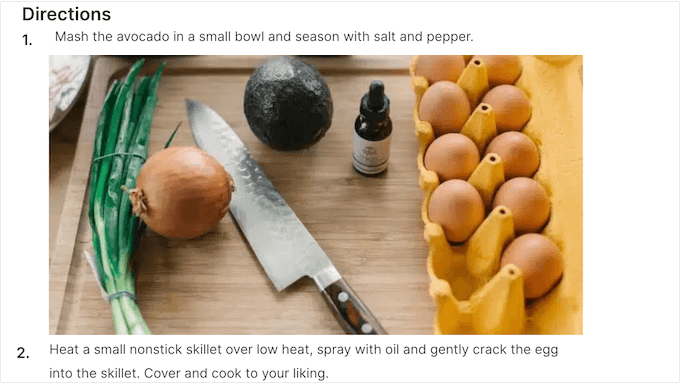
La bonne nouvelle est que Recipe Card Blocks vous permet d'ajouter une image à chaque étape.
Ces images sont facultatives, vous n'avez donc pas besoin d'ajouter une photo à chaque étape.

7. Prise en charge des galeries vidéo
Certains visiteurs préféreront peut-être regarder une vidéo plutôt que de lire des instructions étape par étape. Cela dit, vous pourriez vouloir ajouter des tutoriels vidéo à vos cartes de recettes.
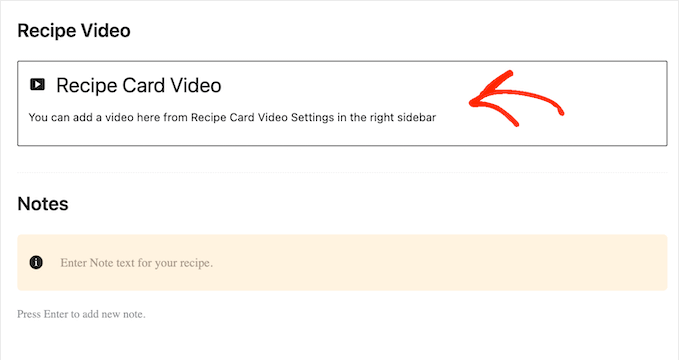
Vous pouvez soit ajouter une vidéo depuis la médiathèque WordPress, soit intégrer des vidéos dans votre carte de recette à l'aide d'une URL.
Cela permet aux visiteurs d'accéder à vos recettes de la manière qui leur convient le mieux. Cela peut vous donner un avantage sur les sites de recettes qui n'offrent que des instructions textuelles.
8. Ajoutez des appels à l'action sociaux
Les photos et le contenu culinaires sont très populaires sur les réseaux sociaux Avec cela à l'esprit, vous voudrez encourager les lecteurs à partager vos recettes sur les réseaux sociaux.
Au lieu d'ajouter un simple bouton de partage social, Recipe Card Blocks vous permet d'ajouter des appels à l'action sociaux personnalisables. Ceux-ci apparaissent dans le pied de page de chaque carte de recette.

Dans les paramètres du plugin, vous pouvez ajouter vos liens Instagram, Pinterest et Facebook. Vous pouvez ensuite taper le call to action que vous souhaitez utiliser.
Une fois cela fait, Recipe Card Blocks ajoutera ces bannières sociales à tous vos blocs de recettes.

9. Ajoutez des informations nutritionnelles
Les étiquettes nutritionnelles aident les lecteurs à prendre des décisions plus éclairées sur les repas qu'ils préparent. Elles peuvent également rendre votre site Web culinaire plus attrayant, surtout par rapport aux blogs de recettes qui ne fournissent pas d'informations nutritionnelles.
Avec Recipe Card Blocks, vous pouvez ajouter des informations nutritionnelles à n'importe quelle carte, ou afficher ces informations séparément en utilisant le bloc Nutrition Facts.

10. Balisage de schéma de recette
Toutes les recettes que vous créez à l'aide de Recipe Card Blocks sont optimisées pour les données structurées de Google et incluent le balisage de schéma de recette.
Ce balisage de schéma de recette est un type de code HTML qui donne aux robots de recherche plus d'informations sur vos recettes. Cela aide les moteurs de recherche comme Google à comprendre votre contenu et à le montrer aux lecteurs qui recherchent ce type de contenu.
De plus, les moteurs de recherche peuvent utiliser ce schéma de recette pour créer des extraits mis en avant. Ceux-ci apparaissent en haut des SERP et incluent des informations supplémentaires, dans un format accrocheur. Par exemple, Google pourrait afficher les ingrédients de votre recette, la note par étoiles, le temps de préparation et d'autres informations dans l'extrait enrichi.
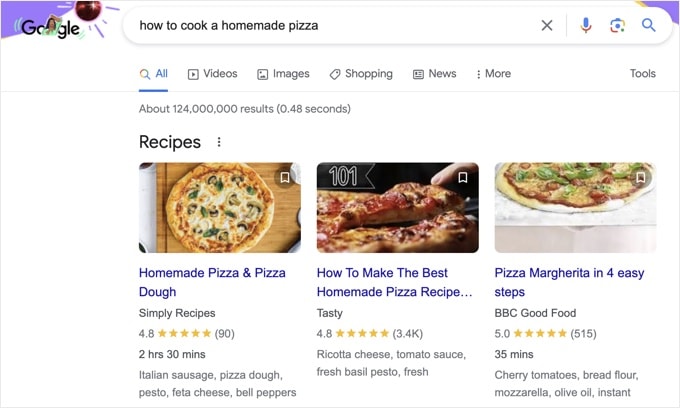
Cela rendra instantanément vos recettes plus visibles dans les résultats de recherche, et pourrait même augmenter le trafic de votre blog.
11. Conforme au RGPD
Le Règlement Général sur la Protection des Données (RGPD) est une loi de l'Union Européenne (UE) qui vise à donner aux citoyens de l'UE plus de contrôle sur leurs données personnelles. Si vous enfreignez cette loi importante sur la vie privée, vous pourriez encourir une amende, voire une peine de prison.
La bonne nouvelle est que Recipe Card Blocks ne collecte aucune information en dehors de votre installation WordPress, et n'intègre aucun Google Fonts. Cela vous aide à vous conformer au RGPD et à éviter les conséquences de la violation de cette loi importante sur la protection de la vie privée.
Cependant, la fonctionnalité de notation par étoiles stocke un cookie chaque fois que quelqu'un note votre recette. Cela permet d'éviter le spam de notation, mais cela a également un impact sur la vie privée du visiteur. Cela dit, nous vous recommandons de mettre à jour la politique de confidentialité de votre site Web, afin qu'il soit clair que vous utilisez des cookies de cette manière.
12. Portions ajustables
Lors de la création d'une recette, vous pouvez spécifier le nombre de portions qu'elle produira.
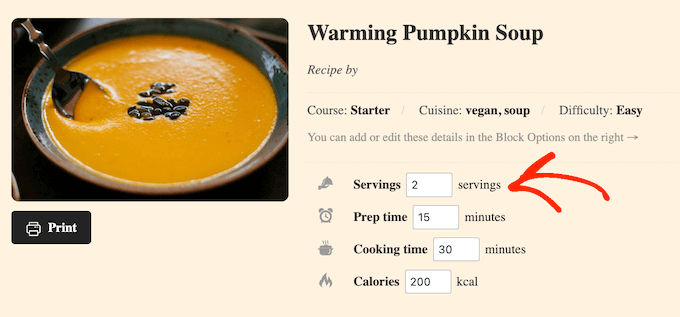
Cependant, il arrive que les lecteurs aient besoin de cuisiner pour plus ou moins de personnes. Dans cette optique, vous serez heureux d'apprendre que Recipe Card Blocks dispose d'une fonctionnalité de portions ajustables, afin que le lecteur puisse adapter vos recettes en toute simplicité.
Lorsque les lecteurs modifient le nombre de portions, la liste des ingrédients se met à jour automatiquement pour produire ce nombre exact de portions. Cela élimine les approximations lors de la cuisine.

13. Afficher les notes par étoiles
Une note par étoiles est une forme simple de preuve sociale qui peut aider les visiteurs à trouver vos meilleures recettes. Cela encourage également les lecteurs à interagir avec votre contenu, en leur donnant un moyen rapide et facile de noter vos recettes.
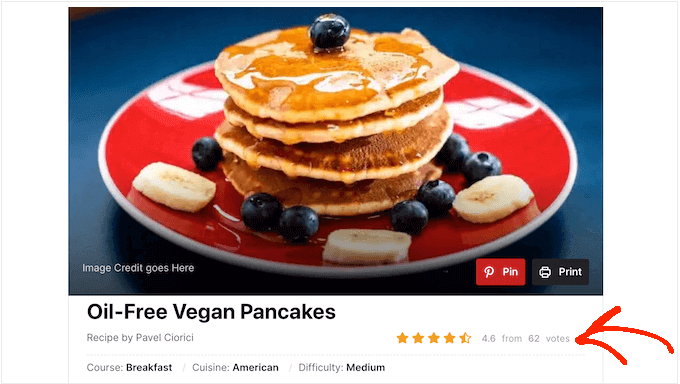
Le plugin affiche également le nombre total de notes pour chaque recette. Un nombre élevé peut convaincre les visiteurs que votre blog est populaire et reçoit beaucoup de visiteurs, ce qui signifie qu'ils sont plus susceptibles d'essayer vos recettes eux-mêmes.
Mieux encore, ces notes par étoiles ont le balisage de schéma correct, elles sont donc plus susceptibles d'apparaître dans les SERP pertinents.
14. Accepter les commentaires des lecteurs
Similaire à l'acceptation des commentaires sur vos pages et articles, les visiteurs peuvent commenter vos recettes. Cela leur donne un moyen facile de partager des commentaires et des astuces, ou de poser des questions.
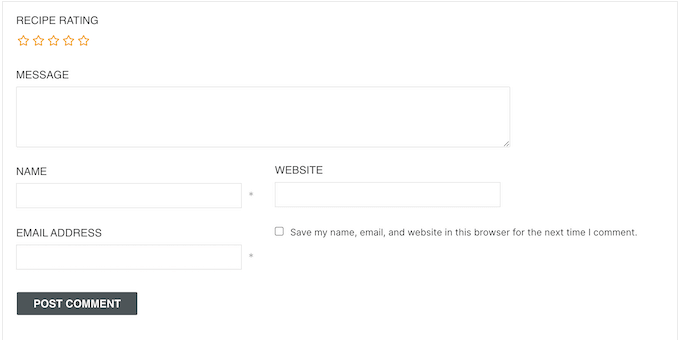
15. Mises en page de recettes personnalisables
Comme nous l'avons déjà vu, vous pouvez ajouter des recettes entières à n'importe quelle page ou article à l'aide du bloc Carte de recette. Cependant, ce plugin dispose également de blocs plus petits qui ajoutent un type spécifique de contenu de recette à la page. Par exemple, il existe un bloc Ingrédients qui ajoute une liste d'ingrédients.

Il existe également un bloc « Sauter à la recette » qui ajoute un seul bouton à la page ou à l'article.
En utilisant ces blocs plus petits, vous pouvez contrôler exactement quel contenu de recette vous ajoutez à la page. Vous pouvez également insérer du texte brut entre les blocs. Par exemple, vous pourriez taper une introduction avant d'ajouter un bloc Ingrédients à la page.
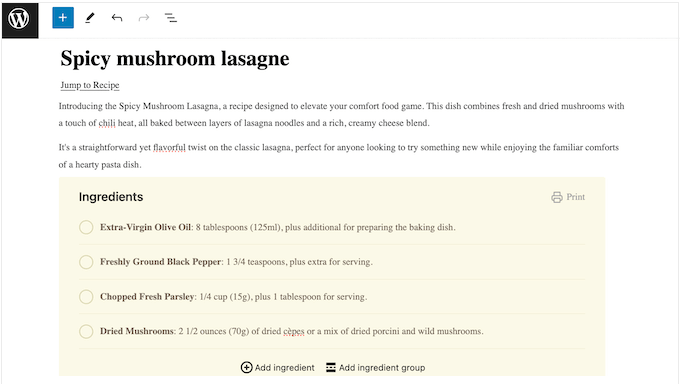
En combinant ces blocs de différentes manières et en les positionnant soigneusement sur la page, vous pouvez créer toutes sortes de mises en page personnalisées pour votre blog WordPress.
16. Gagner de l'argent avec le marketing d'affiliation
Certaines recettes nécessitent un équipement spécial. Cela dit, vous pouvez ajouter une section « Équipement » à vos cartes de recettes, avec une image de l'article dont le lecteur aura besoin.
Vous pouvez même aller plus loin et ajouter un lien d'affiliation, afin que les lecteurs puissent acheter cet équipement.

Le marketing d'affiliation est un moyen populaire de gagner de l'argent en ligne en bloguant avec WordPress, c'est donc un excellent moyen de monétiser vos recettes.
Mieux encore, vous pouvez ajouter chaque équipement et lien d'affiliation à un inventaire. Vous pouvez ensuite ajouter ces informations stockées à toute recette future, en quelques clics. De cette façon, vous pouvez créer une bibliothèque de liens d'affiliation que vous pouvez utiliser sur l'ensemble de votre site Web WordPress.
17. Recettes groupées
Vous souhaitez créer des listes de recettes thématiques ? Par exemple, vous pourriez vouloir afficher vos recettes les mieux notées sur votre page d'accueil personnalisée, ou mettre en avant les recettes « faciles » sur un article de blog destiné aux cuisiniers débutants.
Dans ce cas, vous pouvez utiliser le bloc « Recettes groupées » pour afficher vos recettes sous forme de liste.
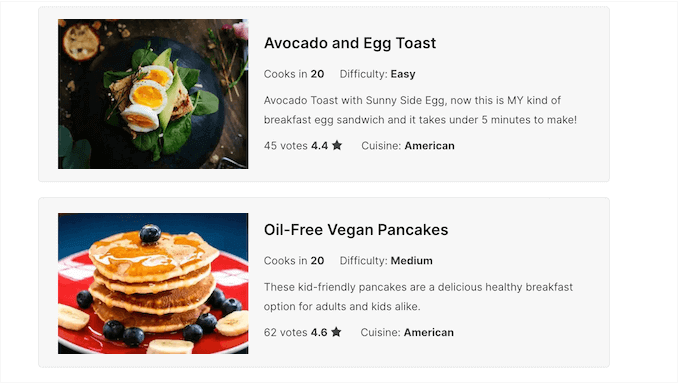
Après avoir ajouté ce bloc à une page ou un article, vous pouvez sélectionner chaque recette que vous souhaitez présenter. Recipe Card Blocks affichera alors ces recettes dans une belle mise en page.
18. Bloc d'index de recettes
Certains lecteurs n'ont peut-être pas de recette spécifique en tête et souhaitent simplement de l'inspiration culinaire. Pour les aider à parcourir votre site, ce plugin fournit un bloc d'index de recettes.
Cela permet aux lecteurs de filtrer vos recettes par cuisine, plat ou difficulté.
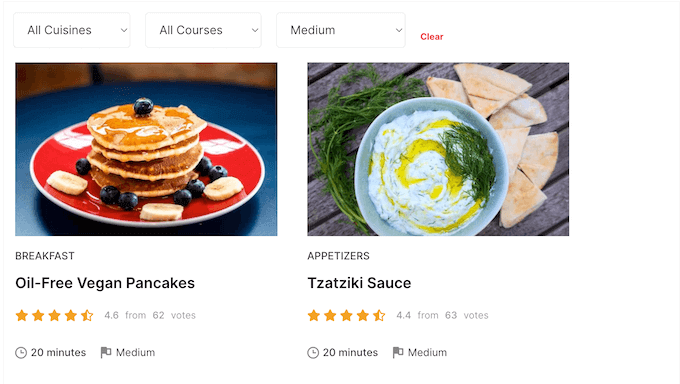
Les lecteurs peuvent même combiner plusieurs filtres pour trouver la recette qui leur convient parfaitement. Par exemple, ils pourraient rechercher un « Dessert » de niveau de difficulté « Facile ».
19. Mode Cuisson
Certains lecteurs peuvent vouloir garder votre recette à l'écran pendant qu'ils la suivent. Pour les aider, Recipe Card Blocks dispose d'un mode Cuisson intégré qui empêche leur appareil de se mettre en veille.
Les lecteurs peuvent activer et désactiver ce mode en cliquant simplement sur un interrupteur.

20. Support Communautaire et Professionnel
Recipe Card Blocks fournit tout ce dont vous avez besoin pour ajouter des recettes à votre site, y compris une sélection de blocs, un éditeur de recettes dédié et des mises en page prêtes à l'emploi.
Cependant, il peut parfois vous falloir une aide supplémentaire ou vous avoir des questions auxquelles vous souhaitez une réponse. Pour commencer, il existe une base de connaissances en ligne où vous trouverez des tutoriels utiles, ainsi que des conseils sur la façon de corriger les erreurs WordPress courantes que vous pourriez rencontrer lors de l'utilisation de ce plugin.

Il y a aussi un blog où ils couvrent une gamme de sujets, tels que comment gagner de l'argent en ligne en bloguant avec WordPress. Vous y trouverez également la sélection d'experts de l'équipe des plugins WordPress indispensables que vous pourriez vouloir utiliser sur votre site Web de recettes.
Si vous utilisez le plugin gratuit, vous pouvez poster sur le forum Recipe Card Blocks sur WordPress.org et obtenir des réponses à des questions de base.
Lorsque vous publiez sur les forums de support publics, il est toujours bon d'inclure autant d'informations que possible, afin que les experts puissent comprendre pleinement votre problème et poster une réponse utile. Pour en savoir plus sur ce sujet, veuillez consulter notre guide sur comment demander correctement le support WordPress.
Pendant ce temps, si vous passez au plugin premium, vous aurez accès au support par e-mail, vous pourrez donc obtenir une aide personnalisée directement auprès des experts.
Avis sur Recipe Card Blocks : Prix et forfaits
Si vous débutez ou si vous avez un budget limité, vous pouvez télécharger la version lite de Recipe Card Blocks depuis WordPress.org. Cela vous permet de créer de belles cartes de recettes avec des images, des vidéos, une liste d'ingrédients et des instructions étape par étape.
Cependant, si vous souhaitez débloquer des fonctionnalités plus avancées, vous devrez passer au plugin premium.

Il y a 3 plans parmi lesquels choisir :
- Débutant. Pour 59 $ par an, vous pouvez installer le plugin sur un seul blog, site web ou boutique en ligne. Ce forfait ajoute le bloc d'index de recettes afin que les visiteurs puissent filtrer vos recettes en fonction de facteurs tels que la cuisine et la difficulté. Il débloque également les Recettes groupées, vous permettant de créer une liste organisée de recettes et de les afficher sur votre site web dans une belle mise en page.
- Professionnel. Au prix de 79 $ par an, ce forfait vous permet d'utiliser les blocs de cartes de recettes sur un maximum de 3 sites web. Les lecteurs peuvent également convertir les recettes entre les unités américaines et métriques, ce qui en fait un choix idéal si vous gérez un site web multilingue ou si vous souhaitez attirer un public international.
- Entreprise. Pour 129 $ par an, vous pouvez installer les blocs de cartes de recettes sur un maximum de 10 sites web. Cela dit, c'est un excellent choix si vous gérez plusieurs sites dans le niche de blogging culinaire. Cela peut également être une bonne option pour les petites agences de développement WordPress qui ont besoin d'une solution qu'elles peuvent utiliser sur les sites web de leurs clients.
Revue de Recipe Card Blocks : Est-ce le bon plugin de recettes pour vous ?
Après avoir examiné les fonctionnalités, le support et les prix, nous sommes convaincus que Recipe Card Blocks est un excellent plugin de recettes. Il vous permet de créer des cartes de recettes que vous pouvez personnaliser en modifiant les couleurs, les mises en page et le contenu.
Quelle que soit la manière dont vous stylisez ces cartes, elles sont livrées avec un schéma correctement formaté pour aider les moteurs de recherche à afficher vos recettes aux personnes qui recherchent du contenu similaire au vôtre. Une fois que les lecteurs découvrent vos recettes, ils peuvent laisser des commentaires et même une note en étoiles.
Au-delà de cela, vous pouvez afficher une liste de recettes n'importe où sur votre site, ou permettre aux lecteurs de filtrer votre contenu en fonction de facteurs tels que la cuisine et le plat.
Nous espérons que cet avis sur Recipe Card Blocks vous a aidé à décider si c'est le bon plugin de recettes pour vous. Ensuite, vous voudrez peut-être consulter notre guide sur comment créer un flux photo Instagram personnalisé, ou consulter notre sélection d'experts des meilleurs logiciels de notification push Web.
Si cet article vous a plu, abonnez-vous à notre chaîne YouTube pour des tutoriels vidéo WordPress. Vous pouvez également nous retrouver sur Twitter et Facebook.

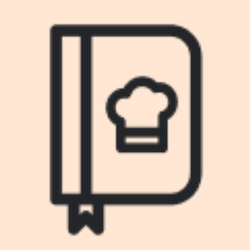

Avis des utilisateurs sur Recipe Card Blocks
Veuillez partager votre avis sur Recipe Card Blocks pour aider les autres membres de la communauté.